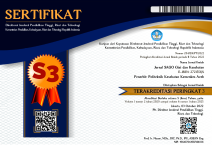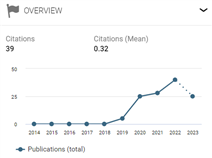Evaluasi kemampuan ekstrak batang jahe (zingiber officinale roscoe) sebagai larvasida alami terhadap nyamuk aedes aegypti
DOI: 10.30867/gikes.v6i1.2100Abstract
Background: The spread of mosquitoes can be stopped by one of the ways, namely by eradicating mosquito nests and killing mosquito larvae. Ginger plants, especially ginger stems, are one of the local plants that can be used as natural larvicide. The active substances in ginger stems are essential oils, saponins, alkaloids and proteolytic enzymes.
Objectives: To determine the ability of ginger stem extract (Zingiber officinale roscoe) as a natural larvicide against Aedes aegypti mosquitoes.
Methods: This study is an experimental research conducted in the laboratory, carried out in July 2024. The sample used in this study was Aedes aegypti instar III mosquito larvae. The treatment involved five effective concentrations of ginger stem extract, namely 0,2%, 0,4%, 0,6%, 0,8%, and 1%, as well as a negative control group using distilled water. Each treatment group consisted of 25 larvae. Data analysis was carried out using the Aedes aegypti larval mortality percentage formula and Probit analysis to determine the LC50 value.
Results: The results of the study showed that the average mortality of larvae at a concentration of 0,2% reached 2 (8%), at a concentration of 0,4% as many as 3 (12%), at a concentration of 0,6% recorded 4 (16%), at a concentration of 0,8% reached 6 (24%), and at a concentration of 1% recorded 11 (44%). In the negative control, no deaths were seen, and the results of the probit test showed an LC50 value of 1,132%, with a lower limit of 0,983% and an upper limit of 1,404%.
Conclusion: Ginger stem extract (Zingiber officinale roscoe) is effective as a natural larvicide against Aedes aegypti mosquitoes with a maximum consumption of 1% achieving 44% mortality and an LC50 value of 1,13%.
Keywords
Full Text:
PDFReferences
Arcusa, R., Villaño, D., Marhuenda, J., Cano, M., Cerdà, B., & Zafrilla, P. (2022). Potential role of ginger (zingiber officinale roscoe) in the prevention of neurodegenerative diseases. Frontiers in Nutrition, 9(March). https://doi.org/10.3389/fnut.2022.809621
Aseptianova, A., Fitri Wijayanti, T., & Nurina, N. (2017). Efektifitas pemanfaatan tanaman sebagai insektisida elektrik untuk mengendalikan nyamuk penular penyakit dbd. Bioeksperimen: Jurnal Penelitian Biologi, 3(2), 10. https://doi.org/10.23917/bioeksperimen.v3i2.5178
Asfi, S. H., Rahayu, Y. S., & Yuliani. (2015). Uji bioaktivitas filtrat rimpang jahe merah (zingiber officinale) terhadap tingkat mortalitas dan penghambatan aktivitas makan larva plutella xylostella secara in-vitro. Jurnal Lentera Bio, 4(1), 50–55. http://ejournal.unesa.ac.id/index.php/lenterabio
Aungtikun, J., & Soonwera, M. (2021). Improved adulticidal activity against Aedes aegypti (L.) and Aedes albopictus (Skuse) from synergy between Cinnamomum spp. essential oils. Scientific Reports, 11(1), 1–12. https://doi.org/10.1038/s41598-021-84159-z
Brady, O. J., & Hay, S. I. (2020). The global expansion of dengue: How aedes aegypti mosquitoes enabled the first pandemic arbovirus. Annual Review of Entomology, 65(October), 191–208. https://doi.org/10.1146/annurev-ento-011019-024918
Britannica, T. E. of E. (2023). Proteolytic enzyme. In Encyclopedia Britannicaclopedia Britannica. https://www.britannica.com/science/proteolytic-enzyme
CDC. (2024). About Mosquitoes. Centers for Disease Control and Prevention (CDC). https://www.cdc.gov/mosquitoes/about/?CDC_AAref_Val=https://www.cdc.gov/mosquitoes/about/what-is-a-mosquito.html
Dhiman, M., Sharma, L., Dadhich, A., Dhawan, P., & Sharma, M. M. (2022). Traditional knowledge to contemporary medication in the treatment of infectious disease dengue: A Review. Frontiers in Pharmacology, 13(March). https://doi.org/10.3389/fphar.2022.750494
Estallo, E. L., Sippy, R., Stewart-Ibarra, A. M., Grech, M. G., Benitez, E. M., Ludueña-Almeida, F. F., Ainete, M., Frias-Cespedes, M., Robert, M., Romero, M. M., & Almirón, W. R. (2020). A decade of arbovirus emergence in the temperate southern cone of South America: dengue, Aedes aegypti and climate dynamics in Córdoba, Argentina. Heliyon, 6(9), e04858. https://doi.org/10.1016/j.heliyon.2020.e04858
Fitriyanti, Nasrudin, & Rudi, L. (2019). Fitokimia dan aktivitas antioksidan kombinasi imbang kulit batang kayu jawa ( lannea coromandelica ) dan rimpang jahe emprit (zingiber officinale var. rubrum). Jurnal Pendidikan Kimia Universita Halu Oleo, 4(2), 102–109.
Gloria-soria, A., Ayala, D., Bheecarry, A., Calderon-arguedas, O., Chadee, D. D., Chiappero, M., Coetzee, M., Fernandez-salas, I., Kamal, H. A., Kamgang, B., Khater, E. I. M., Kramer, L. D., Kramer, V., Lopez-solis, A., Lutomiah, J., Jr, M., Micieli, M. V., Paupy, C., Ponlawat, A., … Health, G. (2017). HHS Public Access. 25(21), 5377–5395. https://doi.org/10.1111/mec.13866.Global
Gold, A. S., Feitosa-Suntheimer, F., Araujo, R. V., Hekman, R. M., Asad, S., Londono-Renteria, B., Emili, A., & Colpitts, T. M. (2020). Dengue virus infection of aedes aegypti alters extracellular vesicle protein cargo to enhance virus transmission. International Journal of Molecular Sciences, 21(18), 1–17. https://doi.org/10.3390/ijms21186609
Hidayah, N., Kurnianto, A., Bhelo, A., & Palgunadi, B. U. (2021). Efektivitas campuran ekstrak daun kelor (Moringa oleifera) dan serai wangi (Cymbopogon nardus l) terhadap mortalitas larva nyamuk Aedes aegypti. VITEK : Bidang Kedokteran Hewan, 11(2), 64–70. https://vitek-fkh.uwks.ac.id/index.php/jv/article/view/86
Indriaty, I., Ginting, B., Hasballah, K., & Djufri. (2022). Assessment cytotoxic assay of Rhizophora plants mangrove using brine shrimp (Artemia salina L) model. IOP Conference Series: Earth and Environmental Science, 951(1), 012070. https://doi.org/10.1088/1755-1315/951/1/012070
Kemenkes RI. (2022). Membuka lembaran baru untuk hidup sejahtera. Laporan Tahunan 2022 Demam Berdarah Dengue, 17–19.
Laksono, F. W., Sari, N. L. S., Salsabila, S., & Kurniasari, L. (2022). Pengaruh insektisida alami ekstrak daun jelatang (urtica dioica l.) terhadap mortalitas larva aedes aegypti. Prosiding Sains Nasional Dan Teknologi, 12(1), 1. https://doi.org/10.36499/psnst.v12i1.7136
Lamin, S., Kamal, M., Pasya, A. N., Nofyan, E., & Marisa, H. (2023). Aktivitas larvasida fraksi aktif daun bakau hitam rhizophora mucronata lamk. terhadap larva Nyamuk Aedes aegypti Linn. Jurnal Penelitian Sains, 25(1), 73. https://doi.org/10.56064/jps.v25i1.782
Li, Y., Hong, Y., Han, Y., Wang, Y., & Xia, L. (2016). Chemical characterization and antioxidant activities comparison in fresh, dried, stir-frying and carbonized ginger. Journal of Chromatography B, 1011, 223–232. https://doi.org/10.1016/j.jchromb.2016.01.009
Louise, C., Vidal, P. O., & Suesdek, L. (2015). Microevolution of aedes aegypti. PLoS ONE, 10(9), 1–16. https://doi.org/10.1371/journal.pone.0137851
Mao, Q. Q., Xu, X. Y., Cao, S. Y., Gan, R. Y., Corke, H., Beta, T., & Li, H. Bin. (2019). Bioactive compounds and bioactivities of ginger (zingiber officinale roscoe). Foods, 8(6), 1–21. https://doi.org/10.3390/foods8060185
Medline Plus. (2022). Dengue. National Library of Medicine. https://medlineplus.gov/dengue.html
Nurhaen, N., Winarsii, D., & Ridhay, A. (2016). Isolasi dan identifikasi komponen kimia minyak atsiri dari daun, batang dan bunga tumbuhan salembangu (Melissa sp.). Natural Science: Journal of Science and Technology, 5(2), 149–157. https://doi.org/10.22487/25411969.2016.v5.i2.6702
Okagu, I. U., Okeke, E. S., Ezeorba, W. C. F., Ndefo, J. C., & Ezeorba, T. P. C. (2023). Overhauling the ecotoxicological impact of synthetic pesticides using plants’ natural products: a focus on Zanthoxylum metabolites. Environmental Science and Pollution Research, 30(26), 67997–68021. https://doi.org/10.1007/s11356-023-27258-w
Qatrinida, Q., Norfai, N., & Kasman, K. (2021). Potensi ekstrak jahe merah (zingiber officinale var. rubrum) sebagai larvasida alami aedes albopictus. An-Nadaa: Jurnal Kesehatan Masyarakat, 8(2), 106. https://doi.org/10.31602/ann.v8i2.3485
Rahmayanti. (2023). Entomologi buku ajar untuk Teknologi Laboratorium Medis (T. Salfiyadi (ed.); I). CV. Dewa Publishing. https://dewapublishing.com/book/entomologi-buku-ajar-untuk-teknologi-laboratorium-medis/
Rahmayanti, R., Hadijah, S., & Fitriana, F. (2022). Potential testing of waste skin onion (allium ascalonicum) as a larvacide against the death of mosquito larvas culex sp. BIOTIK: Jurnal Ilmiah Biologi Teknologi Dan Kependidikan, 10(2), 138. https://doi.org/10.22373/biotik.v10i2.13460
Rahmayanti, R., Putri, S., & Fajarna, F. (2016). Uji potensi kulit bawang bombay (allium cepa) sebagai larvasida terhadap kematian larva nyamuk aedes aegypti. Jurnal Edukasi Dan Sains Biologi, 5(1), 77794.
Rahmayanti, & Safwan. (2022). Monograf Pemanfaatan Ekstrak Rambut Jagung (Zea mays l.) sebagai larvasida nyamuk aedes aegypti. PRODI D III Teknologi Laboratorium Medik Poltekkes Kemenkes Aceh.
Ross, P. A., Axford, J. K., Richardson, K. M., Endersby-Harshman, N. M., & Hoffmann, A. A. (2017). Maintaining aedes aegypti mosquitoes infected with wolbachia. Journal of Visualized Experiments, 2017(126), 1–8. https://doi.org/10.3791/56124
Santi, H. L., & Purnama, S. G. (2016). Uji patogenitas bacillus thuringiensis var. israelensis terhadap larva nyamuk aedes sp . sebagai biokontrol penyebab penyakit demam berdarah dengue di denpasar tahun 2014. Archive of Community Health, 3(1), 14–23.
Shamsi, T. N., Parveen, R., Ahmad, A., Samal, R. R., Kumar, S., & Fatima, S. (2018). Inhibition of gut proteases and development of dengue vector, Aedes aegypti by Allium sativum protease inhibitor. Acta Ecologica Sinica, 38(5), 325–328. https://doi.org/10.1016/J.CHNAES.2018.01.002
Silva, R. G. G., Vasconcelos, I. M., Filho, A. J. U. B., Carvalho, A. F. U., Souza, T. M., Gondim, D. M. F., Varela, A. L. N., & Oliveira, J. T. A. (2015). Castor bean cake contains a trypsin inhibitor that displays antifungal activity against Colletotrichum gloeosporioides and inhibits the midgut proteases of the dengue mosquito larvae. Industrial Crops and Products, 70, 48–55. https://doi.org/10.1016/j.indcrop.2015.02.058
Silvério, M. R. S., Espindola, L. S., Lopes, N. P., & Vieira, P. C. (2020). Plant natural products for the control of Aedes aegypti: The main vector of important arboviruses. Molecules, 25(15). https://doi.org/10.3390/molecules25153484
Siyam, N., Sukendra, D. M., Santik, Y. D. P., Prastika, Y. D., As-Syifa, A. F. S., Fadila, F. N., Supriyono, S., & Utomo, N. I. (2022). Intervensi dan hambatan pencegahan dan pengendalian demam berdarah dengue. Bookchapter Kesehatan Masyarakat Universitas Negeri Semarang, 1, 28–58. https://doi.org/10.15294/km.v1i1.68
Wardani, E. T. (2012). Pengaruh Ekstrak Jahe (Zingiber officinale Rosc.) var. Gajah Terhadap Kualitas Spermatozoa Mencit (Mus musculus) yang Terpapar 2-Methoxyethanol (Doctoral dissertation, UNIVERSITAS AIRLANGGA).
Wiemer, D., Frickmann, H., & Krüger, A. (2017). Denguefieber. Der Hautarzt, 68(12), 1011–1020. https://doi.org/10.1007/s00105-017-4073-6
Refbacks
- There are currently no refbacks.














